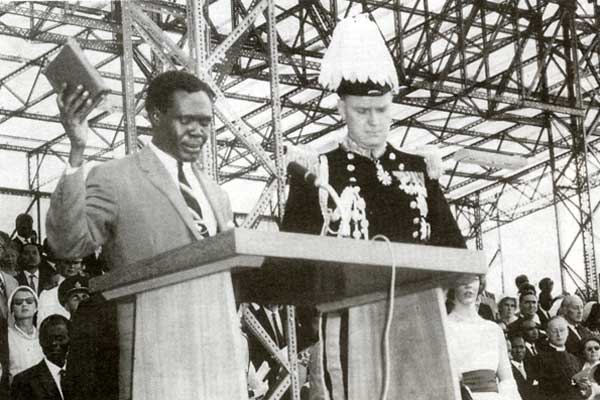How October 9 was arrived at as Independence Day

Milton Obote (left) swears in as Uganda’s first prime minister in 1962.
What you need to know:
- Since Uganda got independence in 1962, there have been some theories that October 9 was chosen to honour Kabaka Muteesa I who died on October 9, 1884, Faustin Mugabe writes.
On October 9, 1962, Uganda got independence from the British. Uganda had been under colonial rule since July 19, 1894, when it was declared a British protectorate during the reign of Queen Victoria.
The independence Constitution of 1962, as well as the day of independence, were debated at Lancaster Conference by both Ugandan and British delegates.
The conference was chaired by Ian Macleod, a British Member of Parliament who was also the Secretary of State for Colonies. The conference lasted about a month and two weeks.
The Lancaster Conference
As the drums of independence sound louder and louder, it became clear to the colonialists that the earlier they granted Uganda independence, the better for the both of them. Across the continent, the calls for independence were unwavering.
In 1960, then Governor of Uganda Fredrick Crawford appointed a constitutional committee, also known as the Wild Report, which sought views of Ugandans on the country they wanted.
The 15-man committee led by retired British Colonel John V. Wild included some Ugandans. It was from the Wild Report that Uganda’s independence constitution was made.
Thereafter, 50 men were selected to represent the British and Ugandan governments, Buganda Kingdom, political parties, districts and urban authorities. It was this 50-man delegation that debated Uganda’s independence Constitution.
The conference was opened at Lancaster House on Monday, September 18, 1961. It was chaired by Secretary of State for Colonies Macleod. The conference held 17 plenary sessions and ended on October 9, 1961.
Why conference
was held in Britain
There were several reasons why the British decided that the conference be held in England. It should be remembered that at the time the conference was held, the political tempo in Uganda was at boiling point.
Some delegates would have been intimidated by radical politicians. And so, the British wanted a conducive environment for the delegates to debate without fear of intimidation, especially if the conference was to be held in central region.
Choosing October 9
From available records, October 9, 1962, was arrived at simply because it was the last day of the Lancaster Conference.
Events at the conference are documented in a report titled ‘Report of the Uganda Constitutional Conference 1961 and Text of the Agreed Draft of the New Buganda Agreement Initialled in London on October 9, 1961.’
The report was also presented to the British parliament by the Secretary of State for Colonies, Macleod.
Chapter VII, paragraph 171 of the report reads: “After careful consideration of the view expressed by delegates, the Secretary of State announced that Uganda would attain internal self-government on March 1, 1962. The Constitution would provide that a general election to the new National Assembly should take place before mid-April.”
“Provided that the necessary discussions could be completed and arrangements made in time, Uganda would attain independence exactly one year from the last day of the conference, i.e. on October 9, 1962,” the report adds.
Theories connecting Muteesa I, Independence
Since Uganda got independence in 1962, there have been some theories that October 9 was chosen to honour Kabaka Muteesa I. He died on October 9, 1884.
In appreciation, the advancers of this theory claim, it was decided that as a token of appreciation to Muteesa I’s contribution to Uganda’s history, October 9 was decided as Independence Day.
These theorists say it was Muteesa I who invited European missionaries who brought Christianity, Western education, infrastructure and national development.
When British explorer Henry Morton Stanley came to Uganda in 1875 and met Muteesa I at his palace, the king wrote a letter asking the British to send missionaries to what would later become Uganda.
His request was granted after Muteesa I’s letter was published in the British Daily Telegraph newspaper in 1875.
Muteesa I died on October 9, 1884, was buried at Kasubi, at the Buganda Royal Tombs in Kampala. His body was wrapped in a bark cloth before it was put in a coffin made of both wood and steel.
The special coffin was made by Scottish lay missionary Alexander Mackay of the Church Missionary Society, according to available records.
Muteesa I ruled Buganda for about 20 years and was succeeded by his son Mwanga.
The Lancaster Conference
In 1960, then Governor of Uganda Fredrick Crawford appointed a constitutional committee which sought views of Ugandans on the country they wanted. The 15-man committee led by retired British Colonel John V. Wild included some Ugandans. It was from the Wild Report that Uganda’s independence constitution was made. Thereafter, 50 men were selected to represent the British and Ugandan governments, Buganda Kingdom, political parties, districts and urban authorities.




